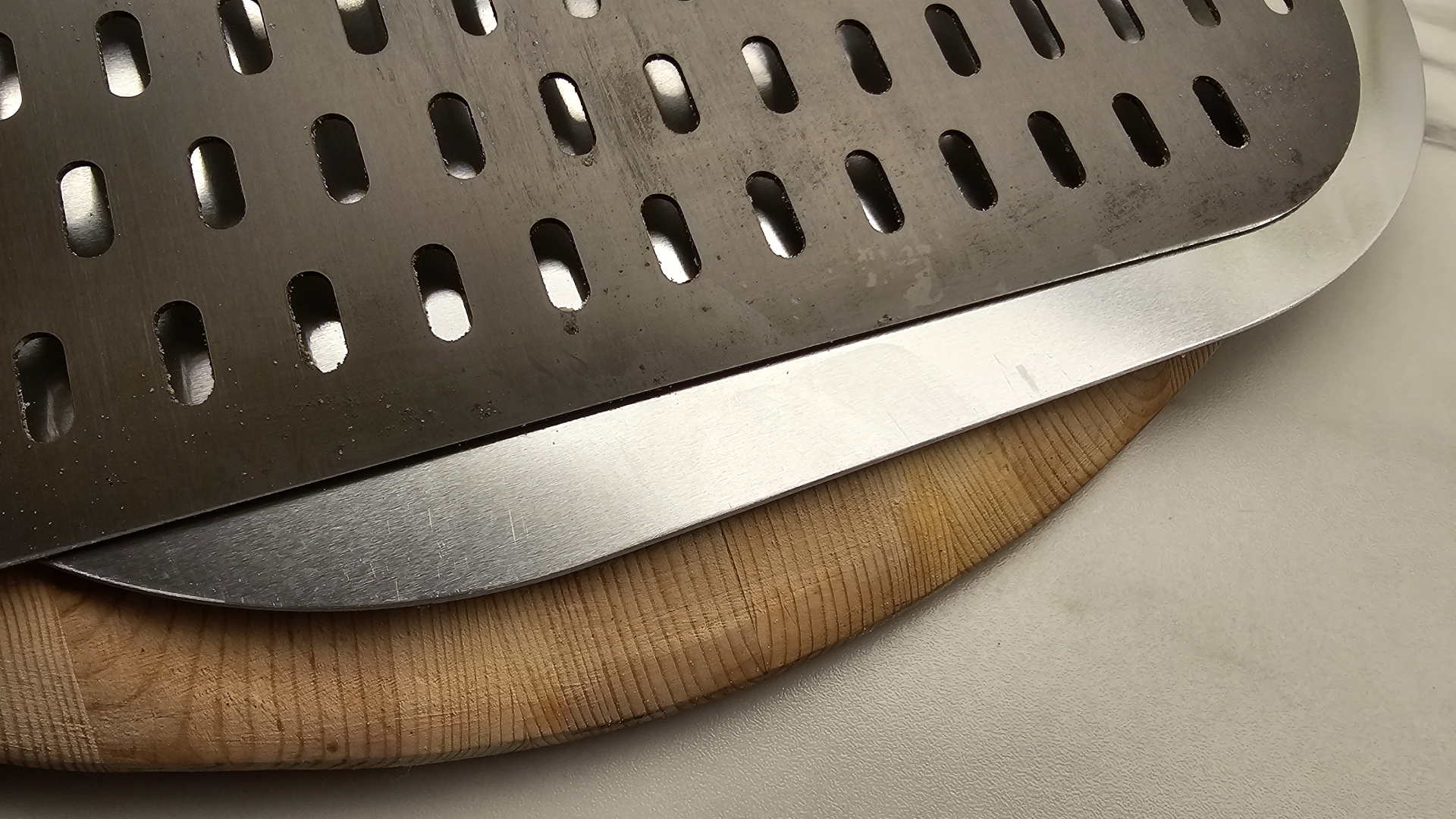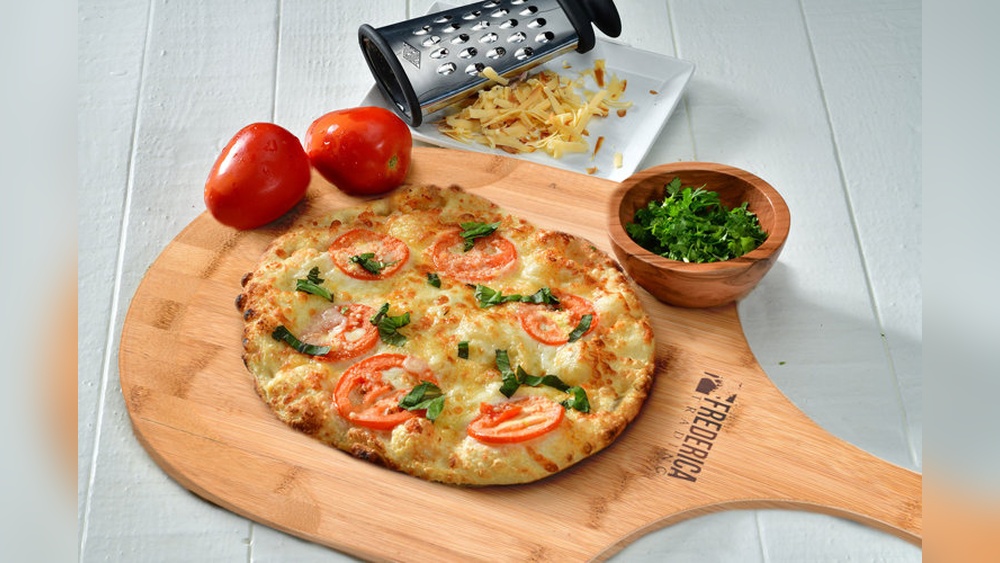When it comes to making the perfect pizza at home, the right tools can make all the difference. One tool you can’t overlook is the pizza peel.
But should you choose a metal peel or a wooden one? This choice can affect how easily you slide your pizza into the oven and how well your crust turns out. If you want to know which peel suits your cooking style and kitchen needs best, keep reading.
By the end, you’ll feel confident picking the perfect pizza peel for your next homemade pie.

Credit: www.acemart.com
Metal Pizza Peels
Metal pizza peels are popular tools for baking pizza. They help move pizzas in and out of the oven quickly and safely. These peels offer a modern touch and practical benefits in the kitchen. Many pizza lovers choose metal peels for their strength and ease of use.
Material And Design
Metal pizza peels are usually made from aluminum or stainless steel. Aluminum is lightweight and conducts heat well. Stainless steel is stronger but a bit heavier. The surface is smooth, which stops dough from sticking. Most metal peels have thin edges for easy sliding under pizza.
Durability And Maintenance
Metal peels last a long time without damage. They do not crack or warp like wood can. Cleaning is simple; just wash with soap and water. Metal peels do not absorb moisture or odors. They resist stains and keep their look after many uses.
Heat Resistance
Metal peels handle high oven temperatures well. They do not burn or get damaged by heat. This makes them perfect for hot pizza ovens. The metal surface cools quickly after use, preventing heat buildup. Metal peels keep their shape even near flames.
Weight And Handling
Metal peels are usually lighter than wooden ones. This helps move pizzas easily without strain. Handles vary from metal to wood or plastic grips. Some peels have longer handles for safety. The balance between weight and strength makes metal peels user-friendly.
Wooden Pizza Peels
Wooden pizza peels have been a classic tool for pizza makers. They offer a natural feel and traditional look. Many chefs prefer wood for sliding pizzas in and out of ovens. Wood’s texture helps prevent dough from sticking. This makes it easier to handle raw pizza dough.
Material And Design
Wooden peels are usually made from hardwoods like maple or birch. These woods are strong and smooth. The surface is flat with a thin edge for easy sliding. The handle is long to keep hands away from heat. The design is simple but effective for pizza tasks.
Durability And Maintenance
Wooden peels need careful cleaning and drying. Water can cause wood to warp or crack. Regular oiling keeps the wood from drying out. With proper care, wooden peels last many years. Avoid soaking them in water or using harsh cleaners.
Heat Resistance
Wood does not absorb heat quickly. This keeps the handle cooler than metal peels. Wooden peels can touch hot oven floors briefly. Still, they should not stay in the oven too long. Wood resists heat but can burn if exposed too much.
Weight And Handling
Wooden pizza peels are lighter than metal ones. This makes them easier to hold and move. The natural grip of wood feels comfortable in the hand. Lightweight design helps to slide pizzas smoothly. It reduces fatigue during long cooking sessions.
Performance Comparison
Choosing the right pizza peel affects how well you handle your pizza. Metal and wood peels perform differently in several ways. Understanding their strengths helps you pick the best tool for your kitchen.
Ease Of Sliding Pizza
Metal peels usually have a thin edge. This makes sliding pizza on and off easy. They glide smoothly over baking stones and ovens. Wood peels have a thicker edge. They need a quick shake or flour dusting to release the dough. Metal peels work best for transferring pizza fast. Wood peels offer more control but require more effort.
Cleaning And Care
Metal peels clean easily with soap and water. They do not absorb moisture or odors. Wood peels need gentle cleaning. Water and soap can damage the wood over time. They should be wiped clean and dried well. Wood may require occasional oiling to stay in good shape. Metal peels need less maintenance overall.
Longevity
Metal peels last longer if handled carefully. They resist warping and cracking. Wood peels can wear down with heavy use. They might crack or splinter if not cared for. Proper care extends wood peel life. Both types can last years, but metal peels tend to stay sturdy longer.
Cost Considerations
Wood peels often cost less upfront. They are simple to make and widely available. Metal peels usually cost more. The price reflects durability and ease of use. Consider how often you bake pizza. A higher cost for metal can be worth the longer life.

Credit: www.amazon.com
Choosing Based On Cooking Style
Choosing the right pizza peel depends on how you cook your pizza. Different cooking styles need different tools. The material of the peel affects handling, heat resistance, and ease of use. Metal and wood peels each have strengths that suit certain cooking environments. Pick the one that fits your pizza-making routine.
Home Oven Use
Wood pizza peels work well for home ovens. They do not get too hot to hold. Wood slides easily under dough without sticking. It helps transfer pizza in and out of the oven smoothly. Metal peels can get hot fast and need care. Wood peels also look nice and feel natural in the kitchen.
Outdoor Pizza Ovens
Metal peels are best for outdoor ovens. They handle high heat without warping or damage. Thin metal blades slide quickly under pizza on hot stones. Metal peels are lighter and easier to maneuver at high temperatures. Wood peels may burn or wear out faster outside.
Commercial Kitchens
Metal peels suit busy commercial kitchens. They are durable and easy to clean. Metal resists stains and heat better than wood. Chefs can work faster with a metal peel’s thin edge. Wood peels might absorb moisture and odors in heavy use. Metal peels keep up with fast pizza production.
Safety And Comfort
Safety and comfort are key when using a pizza peel. Handling hot pizzas and ovens needs care. Choosing the right material affects your safety and ease.
Grip And Control
Wood pizza peels offer a natural, non-slip grip. They feel warm and soft in your hands. Metal peels can be slippery if wet or greasy. Some metal peels have textured handles for better grip. Wood handles usually provide better control for sliding pizzas.
Heat Protection
Wood peels stay cooler longer and reduce burn risk. They do not conduct heat like metal peels. Metal peels can get very hot near the oven. Always use oven mitts or heat-resistant gloves with metal peels. Wood peels help protect your hands during long baking sessions.

Credit: thepizzaheaven.com
Additional Features To Consider
Choosing between a metal and wood pizza peel is not just about the material. Some extra features can make your cooking easier and safer. These features help you handle the peel better and store it without trouble. Think about what fits your kitchen and pizza style.
Handle Length And Material
Handle length affects how far you can reach into the oven. Longer handles keep your hands away from heat. Short handles offer more control but need you to be closer to the oven.
Metal handles are strong and often thinner. They may get hot faster. Wooden handles stay cooler and feel comfortable. Some handles mix wood and metal for balance.
Storage Options
Storage matters if kitchen space is small. Some peels have holes in the handle for hanging. Hanging saves drawer space and keeps the peel easy to find.
Flat peels stack well with other kitchen tools. Thick wooden peels need more room. Choose a peel that fits your kitchen storage style.
Frequently Asked Questions
What Are The Main Differences Between Metal And Wood Pizza Peels?
Metal pizza peels are thin, lightweight, and heat-resistant, ideal for sliding pizzas easily. Wood peels are thicker, heavier, and provide a sturdy surface, great for assembling pizzas and preventing sticking.
Which Pizza Peel Is Better For High-temperature Ovens?
Metal pizza peels are better for high-temperature ovens because they withstand extreme heat without warping. Wood peels can scorch or crack under intense heat, making metal safer for hot ovens.
How Do Metal And Wood Peels Affect Pizza Handling?
Metal peels offer better maneuverability due to their thin edges. Wood peels provide more stability when transferring raw dough or assembled pizzas, reducing the risk of toppings falling off.
Are Metal Or Wood Pizza Peels Easier To Clean?
Metal pizza peels are easier to clean because they resist stains and don’t absorb moisture. Wood peels require more care, often needing hand washing and thorough drying to avoid damage.
Conclusion
Choosing between metal and wood pizza peels depends on your needs. Metal peels are thin and easy for sliding pizzas in and out. Wood peels feel sturdy and keep dough from sticking. Both types last long with proper care. Think about how often you bake and what suits your kitchen.
Either way, a good peel makes pizza baking smoother and more fun. Try both to see which fits your style best. Enjoy making delicious pizzas at home with the right tool in hand.

